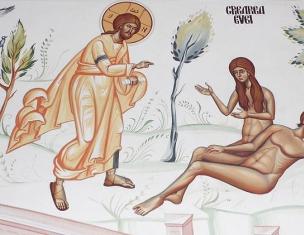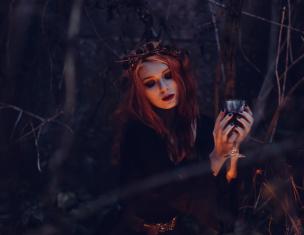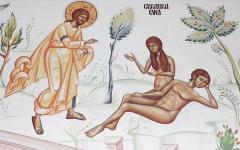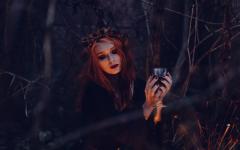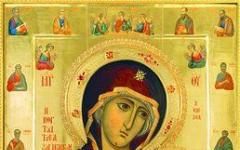It's a sin to complain!
Church of Our Lady (Onze-Lieve-Vrouwekerk, also known as Notre Dame in Bruges) - a Gothic Temple with the second tallest tower in Belgium (122 meters; the tower of the church of the same name in Antwerp is one meter higher) with a sharp finial and four bells around it , which is visible almost everywhere in Bruges, was built in the 12th-13th centuries.
It is difficult to photograph the Temple - it is “sandwiched” by neighboring buildings:


Today, the internal design of the Temple is somewhat unusual: there is, so to speak, a “front” part, open to all visitors, and behind the altar there is an impressively sized “back” part, in which the main artistic and historical values are located, and to which entrance is paid.
This is how we saw the interior of the church in the “front” part of it:
general view (attention: at the top is a crucifix dating back to 1594!):



Traditional pre-altar partition:


A very unusual composition: little Jesus with... dad:

and here he is with the “representative of the true Father”:

Naturally, the mother of Jesus is represented in the Temple dedicated to her in a variety of ways:


Regarding the following artistic object, let us quote an excerpt from the accompanying text:
“This version of the image of the manger of the baby Jesus is carved from the trunk of a thousand-year-old elm tree, which was cut down in the Belgian town of Knesselare. The dead tree was going to be thrown away as useless, but the priest and amateur sculptor Omer Gilliet from the small port town of Breskens created something new, valuable and living from it. Just as parents often talk about their children as gifts from God, so in this creation of his the author saw a gift from Heaven. The fact that this sculpture belongs to Bruges, the generally recognized “city of bridges,” contains a special meaning: Jesus himself represented a kind of bridge between G-d and people.”

Perhaps the main artistic value of the church, which attracts tens of thousands of tourists every year, is located in one of the four side aisles (dating from the end of the 12th century) of the public part; here you can see the passage to this chapel:

In the center of the composition is the only sculptural work of the great Michelangelo Buonarroti (Michelangelo di Francesci di Neri di Miniato del Sera i Lodovico di Leonardo di Buonarroti Simoni) “Madonna and Child” (often called the “Madonna of Bruges”), which left (in 1506) its borders Italy during the author's lifetime:


This small (only 127 cm) work is sculpted from Carrara marble (marmor lunensis), like Michelangelo’s David in Florence. This is what the famous author of biographical novels Irving Stone (Tennenbaum) wrote about this Madonna: “She resisted, did not want to let go of this beautiful, strong and agile boy, who grabbed her protecting hand with his little hand - that’s why she covered son with the edge of his cloak. The boy, feeling his mother’s mood, also has sadness lurking in his eyes. He is full of strength and courage, soon he will jump off his mother’s lap and leave this safe refuge, but now, at this moment, he grabbed his mother’s hand with one hand and pressed the other to her thigh. Perhaps he is thinking now about her, about his mother, saddened by the inevitable separation: her son, so trustingly clinging to his knees, will soon wander alone in the world.”
Before moving to the “back”, paid part of the Temple, we will show fragments of two other side chapels:


In the “back”, or rather, behind the altar, there is another treasure of the church - the tomb of the Duke of Burgundy, Charles the Bold, who died in the Battle of Nancy in 1477, and his daughter, Mary of Burgundy, mother of Emperor Charles V, who died at the age of 25 in 1482 from an accident when falling from a horse. Her choice - marriage to the heir to the Habsburg crown, Maximilian - had a decisive impact on the fate of Europe. If Mary’s choice had been different, she would have preferred the French Dauphin - and there would not have been a great Habsburg empire, and the current map of Europe could have been completely different...



There are also two graves nearby, the history of which remains unknown to us, but they are of undoubted interest from the point of view of design:


You can also see several works of sacred jewelry there:


There are many works of painting in the church. Here are a few that we found interesting and at the same time convenient for photographing:
a very interesting wall example of a mixture of sculpture and painting:

Adriaen Isenbrandt: “Onze Lieve Vrouw van Zeven Smarten (Our Lady of the Seven Sorrows)”:

This is just one of many paintings inspired by the gospel story. For information, another creation on this topic, created by the great Albrecht Dürer:

Pieter Pourbus: “Het laatste avondmaal (The Last Supper)”:

Michelangelo Merisi da Caravaggio (Caravaggio): “Cena in Emmaus (Dinner at Emmaus)”:

This is one of several paintings Caravaggio painted on this biblical theme. The most famous of them is in the National Gallery in London (note how unusual the appearance of Jesus is here):

This theme inspired many painters. Here is a painting by the great Rembrandt exhibited in the Louvre:

Hendrik Van Minderhout: "Binnenzicht van de Onze-Lieve-Vrouwkerk (Interior of the Church of Our Lady)" (2nd half of the 17th century):

Group portrait of the city elite:

Samples of wooden sculpture - design elements for confessional booths:


Of course, we couldn’t calmly pass by the stained glass windows:




Well, and finally, upon leaving the Temple we saw this sculpture on the wall of a nearby house:

- Address: Mariastraat, 8000 Brugge, Belgium
- Telephone: +32 50 34 53 14
- Height: 116 m
- Material: brick
- Architectural style: Gothic architecture
- Date of foundation: 12-13th century
It is a kind of treasury in which amazing and interesting architectural objects are hidden. Despite its small size, this city has museums, architectural and historical monuments at literally every step. Walking around Bruges, it is impossible not to notice one of its main attractions - the Church of Our Lady.
Architectural styleThe temple is an architectural complex consisting of several buildings. Before appearing before the public in its current form, the church went through a long and painful construction. Today it is the tallest building in. Its 45-meter spire seems to pierce the open Flemish sky. This building, whose height is more than 120 meters, cannot help but stand out against the background of other historical buildings in the city.
At the entrance to the Church of Our Lady in Bruges, you can see two-meter figures of the twelve apostles, as well as the figure of a woman who personifies Faith and the Good News. The early Gothic central nave rises above the side naves and is crowned with a cruciform vault. The western part of the temple is an exact copy of the church in. It is also made of blue stone. Five arches and a three-sided apse crown the main altar, which is decorated with asymmetrical pilasters, columns and patterned capitals.
Main attractions of the churchThe Church of Our Lady in Bruges is unique not only because it combines Gothic and Romanesque styles. It is primarily known for housing the sculpture “Virgin Mary and Child,” which was created by the hands of Michelangelo himself. The sculpture was created in 1505 and is considered the only work that was exported from Italy during Michelangelo’s lifetime. It was originally created for the Siena Church, but the author sold it to an unknown merchant, who donated it to the Church of Our Lady in Bruges. During the French Revolution and the German occupation, the statue was stolen, but was returned both times.
Another attraction, or one might say relic, of the Church of Our Lady in Bruges are two sarcophagi with beautiful tombstones. In one of them lies the last Burgundian ruler, Charles the Bold, and in the second, his daughter Maria. Maria lived a short but happy life. She was the wife of Maximilian I of Habsburg, who called her the most beautiful woman in the world. In addition to these relics, the temple houses the remains of famous clergy:
- Bishop of Mainz;
- Hilarius;
- Cyrobaldus.
The Church of Our Lady is located on Mariastraat between two other Bruges streets - O.-L.-Vrouwekerkhof-Zuid and Guido Gezelleplein. The Picasso Museum is open next to it. The Brugge O.L.V bus stop is located just 68 meters from the church. Kerk, which can be reached by routes no. 1, 6, 11, 12 and 16.
 |
Sergey, you are the worst travel blogger in the world. Why didn’t you call your story about a walk through Bruges “Fairytale City”, “Venice of the North”, or at least “Lay Down”? Maybe you didn’t like Bruges either?
- Dear reader, I have already visited Venice, Alsace and Porto. I love these places. If I had grown up on a farm, Bruges might have impressed me, but since it didn't, Bruges doesn't do a damn thing.
Of course, of course, in my free quote from the popular film about Bruges, I am greatly exaggerating. Bruges is beautiful and gothic, walking around it is pure pleasure and delight. But there is still some truth in this imaginary dialogue. Apparently, I really have become a little hardened during my trips to Europe, so I warn you right away that there will be no pompous epithets, pink snot and fairy-tale unicorns in my stories. In general, let's just calmly and without hysterics take a walk around Bruges and look at its main attractions.
In the first part we will walk from the station to the Market Square. I depicted the walking route on my Bruges sightseeing map.
Let me remind you that we chose our base for traveling around Belgium. We went to Bruges for one day, and I’ll say right away that this time will not be enough for the city. Yes, we managed to go around almost the entire historical center, but we didn’t have enough time for museums, and they are more than worthy here. In addition, I admit that if I had spent the night and drank more beer in Bruges, then the impression of the city would have been much stronger. Therefore, I recommend staying here for a couple of days, you won’t be bored.
So, we arrived in Bruges by train from, the journey was not delayed for me, getting here from Ghent or Brussels is easy. Building Bruges station it seemed very modest, cooler in Ghent, and even less comparable to the fantastic Antwerp station.
Seven (!) traffic lights in a small area near the station. I think I have never seen such concentration anywhere else.
The first attraction was Powder Tower 15th century. The bridge that was occupied by tourists, by the way, is also historical.
And here is the answer to why there are so many tourists on the bridge. It offers a picturesque view of Lake of Love (Minnewater). Knowing the gloomy disposition of the peoples of the northern part of Europe, I decided that someone had probably drowned himself here, and I was almost right.
The girl Minna was in love with the warrior Stromberg, for some unknown reason she hid her choice from her father. Unfortunately, the war began, and Stromberg went to fight. Minna's father, an old sailor, felt that he would soon go to his grave and decided to arrange his daughter's future. Hoping that over time she would be able to convince her father, Minna played for time, not agreeing to the marriage. But the old sailor’s patience came to an end, and he declared that after the third sunrise the marriage would be concluded.
Minna decided to run away from home to wait for Stromberg and spent all this time wandering around the woods. When the warrior returned and found the girl in the forest (apparently, she was not hiding too carefully), she was already on her last legs and died in Stromberg's arms. All this happened in the very place where the Powder Tower now stands. The warrior decided to arrange an original grave for his beloved; he blocked the river, placed Minna’s body in the grave in a dry riverbed and let the water flow again. This is how the Lake of Love was formed.
Further, the guidebook recommends that you swear your love to your chosen one on the bridge near Lake Minnewater, supposedly such an oath will be eternal and inviolable. I’m not sure that the bridge near the Powder Tower is the one where this should be done, but it was still not relevant to me, because... I was traveling with my friend.
Several interesting buildings overlook the shores of the lake. For example, the neo-Gothic castle de la Faille, which belonged to a wealthy Dutch family.
The Lake of Love is of artificial origin; in fact, it is a dam. The dam that regulates the water level is located on the site of this house Sashuis.
Sashuis- literally translated from Dutch as a locked house.
The lake of the same name is located next to the lake. Minnewater Park.
I am indifferent to parks, so I walked along the opposite bank, from where impressive brick buildings looked out.
My next goal was Beguinage Bruges. A couple of minutes along a beautiful alley on the shore of Lake Love.
And now the houses of Beguinage begin to peek out from behind the wall.
Beguinage in Bruges dates back to the 13th century, although of the buildings from this time only the church portal has survived. The territory of Beguinage is surrounded by walls and a moat of water, which makes this place isolated from the world. Beguines are often mistaken for nuns. This is not entirely true. They are solitary women who are members of a free community. Unlike real nuns, beguines do not take monastic vows: they can leave the community at any time, return to secular life and get married, and can have their own income and real estate. Today, Benedictine nuns and single women live on the territory of the Beguinage.
On the bridge in front of the entrance to the Beguinage Bruges there is a landmark marking the border between the city and the Beguinage. This clearly illustrates his autonomy. Inscription Sauve Garde above the entrance gate speaks of the right of refuge in this territory. The name of the beguinage “Ten Wijngaerde” translates as “In the Vineyard” and refers to the Vineyard of the Lord.
Beguinage is not very popular among tourists, everyone immediately runs from the station to the Market Square, so it is quite calm and relaxed here.
How have I managed not to write about the swans of Bruges yet? Also a kind of landmark of the city. They even have their own (pseudo?) historical legend. When Maximilian of Austria arrived in Bruges in the 15th century to quell a rebellion, he was captured and his advisor, Pieter Lanhals, beheaded. Maximilian, after his release and return to power, decided to punish the people of Bruges and perpetuate the memory of his adviser. And since Lanhals translates as long-necked, then the witty Maximilian, obliged the inhabitants of Bruges to forever divorce long necks, i.e. swans on the city canals.
Well, Beguinage is good, but it’s time to move to the next attraction, the spire that sticks out from behind the trees and roofs of houses. While we are in the very south of Bruges, we still have to walk quite a bit to get to the center.
In the cafes adjacent to the Beguinage, the theme of nuns is played out with varying degrees of frivolity.
The horse drinking fountain is shaped like... a horse.
In Bruges I turned my . Many streets are beautiful in themselves, so I would like to imagine myself as a Google machine, driving along the streets and taking a photo every meter.
On the way to the center I came across a beautiful Walplein Square. There was once a city wall here, but the city has grown significantly since the 12th century. There are many cafes and bars with craft beer on the square. If I'm not mistaken, there are even several well-known establishments among beer lovers with their own breweries, De Halve Maan, for example. But it was still early, and I was not ready to use it yet.
The square is home to one of the wackiest sculptures in Bruges. The sculpture is called Zeus, Leda, Prometheus and Pegasus visit Bruges. Zeus is depicted as a swan (remember the legends about Zeus and the swans of Bruges), however, in my photo he was obscured by Leda’s bare thigh.
And, again, a little Google panoramas.
The picture below shows a completely normal street, and not some kind of passage or dead end. I like this Bruges!
An impressive building overlooks the canal Sint Jan Hospital. Built for the infirm citizens and pilgrims, the hospital still serves its purpose and is run by the Augustinian sisters, most of whom were trained as Sisters of Charity. The courtyard * leaves a pleasant and peaceful impression, as does the interior of the building, with its long whitewashed corridors and magnificent oak furniture. Inside is a powerful museum displaying the best paintings of Hans Memling, the great artist born in Bruges in the 15th century. Alas, it didn’t work out with museums this time; first of all, I wanted to have time to walk around the city.
A few steps from the hospital there is an even more spectacular building - Church of Our Lady. The bell tower of the church is one of the main dominant features of Bruges; its height is 122 meters, it is the second tallest brick building in the world. Well, it’s simply amazing, especially considering that this is almost the 12th century.
Church of Our Lady in Bruges (Belgium) - description, history, location. Exact address and website. Tourist reviews, photos and videos.
- Tours for the New Year all over the world
- Last minute tours all over the world
Previous photo Next photo





The Church of Our Lady is interesting - it is not only a building that combines features of the Gothic and Romanesque styles, but also one of the few churches outside Italy where Michelangelo’s sculpture “The Virgin Mary and Child”, the so-called, has been preserved. Madonna of Bruges. It was originally intended for the Siena Cathedral, but was acquired by a merchant from Bruges, who then donated it to the church.
The Church of Our Lady is the tallest building in Bruges, with its 122m high tower dominating the cityscape.
The donor himself and his family are buried at the foot of the altar in front of the statue. The statue was stolen twice (by the French in the 18th century and by German occupiers in the 20th century), and twice it was returned to Bruges.
The massive structure, piercing its long spire into the postcard Flemish sky, amazes with the diversity of architectural styles that it has absorbed over its 200-year construction history. Founded in the time of Saint Boniface, the Church of Our Lady was rebuilt in 1120 by Charles the Good, Count of Flanders, and enlarged in 1170.
The church is famous for the burial place of Mary of Burgundy, the wife of Maximilian I of Habsburg, who lived a very short life. The emperor loved his wife very much and considered her the most beautiful woman in the world.



